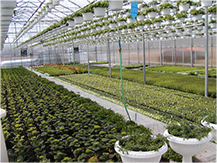
The key to growing successful greenhouse bedding plants, color bowls and/or hanging basket flowers is in balancing the need to push plant growth under often challenging growing conditions as light levels fluctuate wildly due to weather. The ideal media pH is 5.3-5.8. These recommendations are for petunias, calibrachoa, impatiens and most annual flowers except for begonias and geraniums. Another ISP crop sheet covers begonias and geraniums. Please note that this program is presented as a guideline only based upon research and the experiences with a number of growers. With the wide variances possible from both media types, water quality and environmental conditions present during any particular season, your actual recommendation can vary from what is presented. It is always advisable to discuss actual management practices with your local ISP specialist.
Petunias are heavy feeders requiring a constant feed of 260-300ppm of nitrogen and they also have an elevated iron (Fe) requirement. One way to use only a single 200ppm nitrogen constant feed program throughout your greenhouse(s), that will also satisfy most other annual flowers, is to supplement petunias with an application of pelleted slow release fertilizer such as Osmocote or Nutricote once they are planted in their final pots. Add 2/3 of the recommended amount of pelleted fertilizer per pot when constant feeding at 200ppm nitrogen through your fertigation system.
 Petunias require substantial iron to maintain good color and growth. Iron deficient plants will have yellowing leaves with dark green veins and poor growth. Chelated Fe and ferrous sulfate are the most common supplements. These materials can be applied both foliarly and through fertigation. A high pH irrigation solution aggravates iron deficiency. Follow label directions when using an iron supplement.
Petunias require substantial iron to maintain good color and growth. Iron deficient plants will have yellowing leaves with dark green veins and poor growth. Chelated Fe and ferrous sulfate are the most common supplements. These materials can be applied both foliarly and through fertigation. A high pH irrigation solution aggravates iron deficiency. Follow label directions when using an iron supplement.
If media pH is managed at 5.3-5.8 and chelated iron provided as needed, producing a great crop of annual flowers looks easy. Most growers will need to inject acid with every irrigation and fertigation to keep media pH within the desired range. Work with your ISP crop consultant using the acid recommendations from the AlkCalkc online calculator to correctly reduce water pH. If your pH is too low, then applications of liquid lime or potassium bicarbonate are in order. Again, contact your ISP crop consultant for assistance in managing water chemistry.
There is a role for biostimulants such as MetaboliK SB and MetaboliK HV-1 in flower production. Including MetaboliK SB at 1.6oz per 10 gallons of solution at transplanting will speed establishment and enhance rooting. Including one of the bioinoculants such as RootShield Plus, Actinovate, Terra Grow, Cease or Companion will enhance the effect of the MetaboliK as well as provide a good measure of soil-borne disease resistance. Research began in 2016 at the Penn State Southeast Agricultural Research and Extension Center on using MetaboliK HV-1 to promote flower production, and in finishing annuals. The initial observations appear quite promising, and as additional data is gathered this information will be updated.
The primary plant food used by most flower growers is 17-4-17 Flower Special. This low phosphate (P) formula aids in managing plant stretch while providing sufficient nitrogen (N) and potassium (K) for optimal plant and flower growth. Switch to, or Add in, 10-20-20, or 20-20-20 if P levels start to drop.
| ISP Soluble Plant Food | 200ppm | 300ppm |
| 17-4-17 | .98 pounds | 1.5 pounds |
| 20-20-20 | .83 pounds | 1.25 pounds |
| 10-20-20 | 1.70 pounds | 2.55 pounds |
When finishing 4” or larger pots, hanging baskets or color bowls, be sure to apply a timed-release pelleted fertilizer before shipping. This application of plant nutrients will greatly help in keeping your plants in better condition as they are handled by often inexperienced resellers and gardeners.
